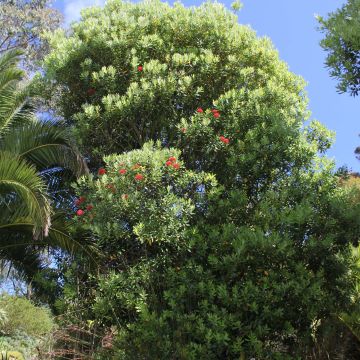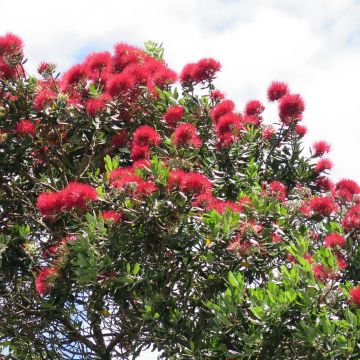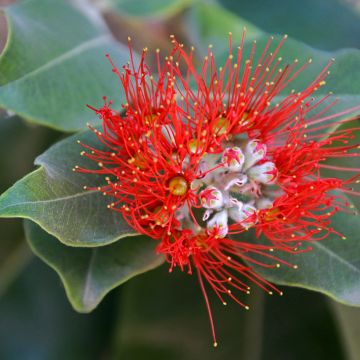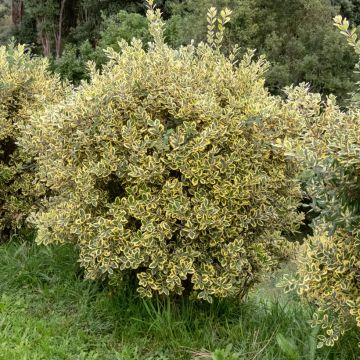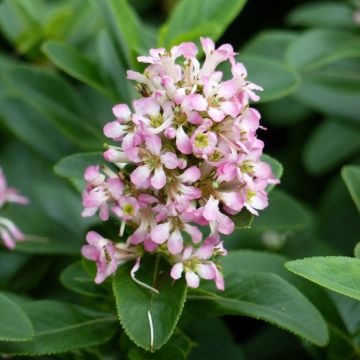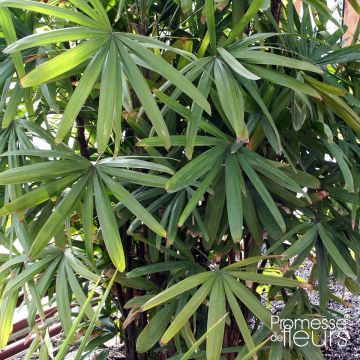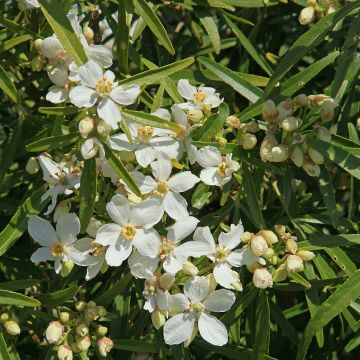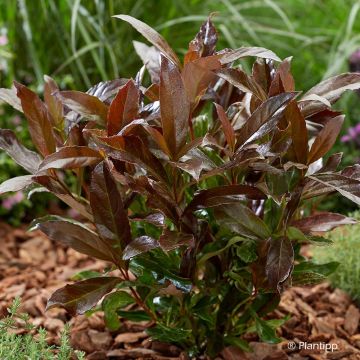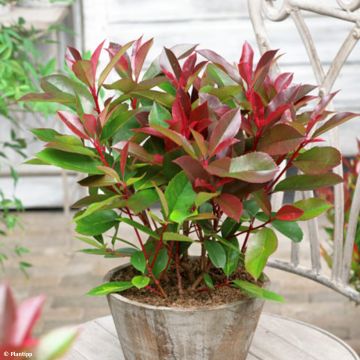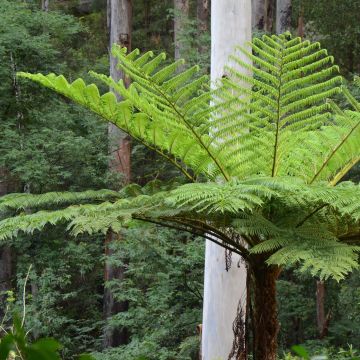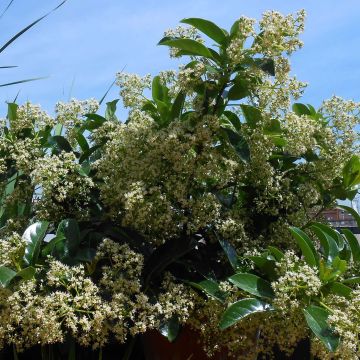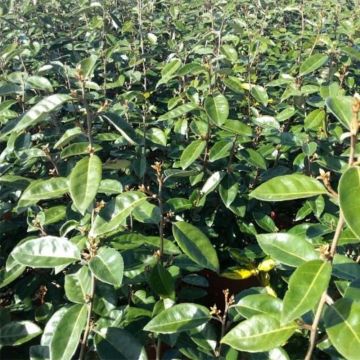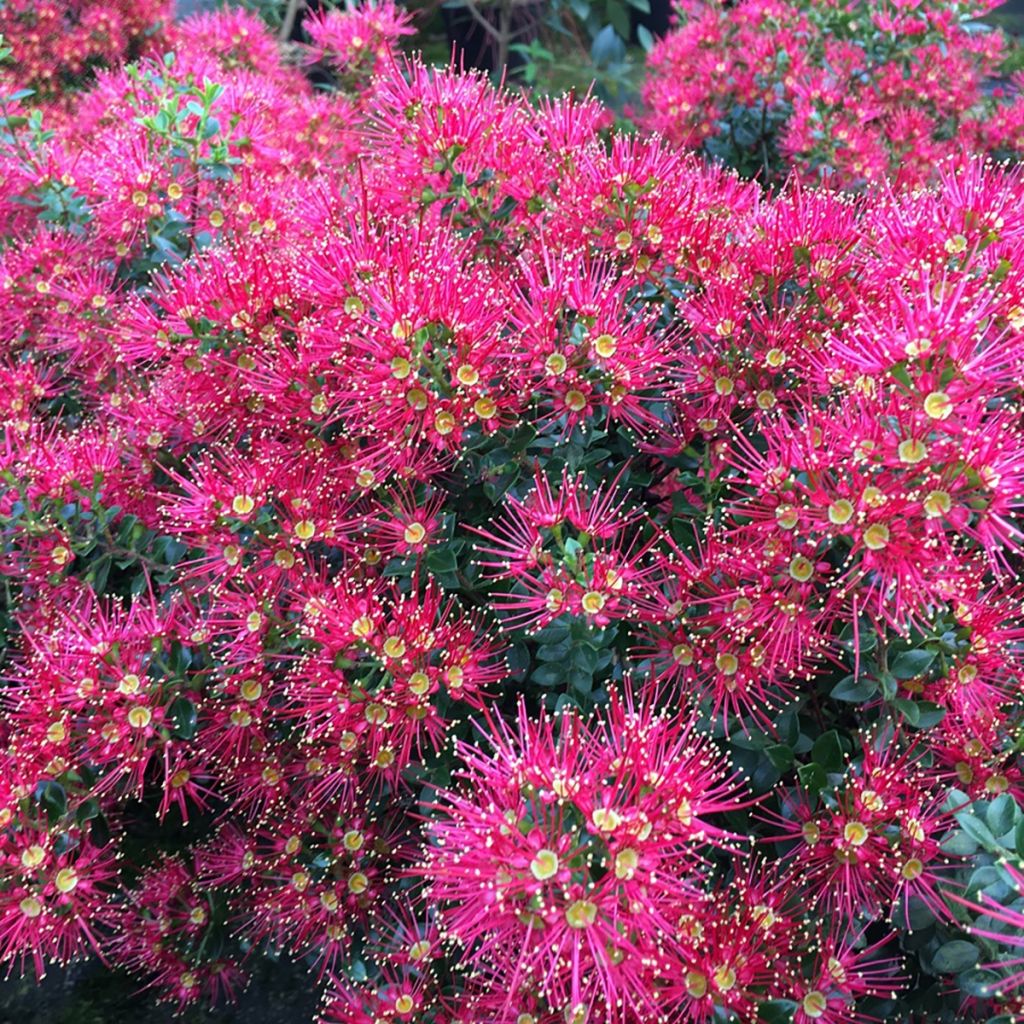

Metrosideros Ferris Wheel
Metrosideros carminea Ferris Wheel
Metrosideros carmineus Ferris Wheel
Crimson rata Vine
Why not try an alternative variety in stock?
View all →This plant carries a 24 months recovery warranty
More information
We guarantee the quality of our plants for a full growing cycle, and will replace at our expense any plant that fails to recover under normal climatic and planting conditions.
From €5.90 for pickup delivery and €6.90 for home delivery
Express home delivery from €8.90.
Delivery to Corse prohibited: UE law prohibits the import of this plant from mainland France to Corse as part of the fight against Xylella fastidiosa. Please accept our sincere apologies.
More information
Does this plant fit my garden?
Set up your Plantfit profile →
Description
Metrosideros carminea 'Ferris Wheel' is derived from an unusual climbing bush from New Zealand called Scarlet Myrtle or Climbing Rata. 'Ferris Wheel' is characterised by a compact growth habit, dark and glossy foliage, and particularly generous flowering. Its vegetation forms a small bushy mass covered with scarlet pompoms in spring. This less hardy selection is perfectly suited for container cultivation, allowing it to be overwintered like a citrus plant. A delightful subject to place on an exotic patio, it will thrive in the ground in the most sheltered gardens.
Metrosideros carminea 'Ferris Wheel' was introduced to the New Zealand horticultural market around 1978. It was obtained by propagating a branch from a typical Metrosideros carminea which had a particular appearance. The botanical species is an endemic forest liana found along the coasts and plains of the North Island in New Zealand, with a hardiness that does not exceed -5°C (23°F) once fully grown. All these plants belong to the Myrtaceae family, like myrtles, Eucalyptus, and Callistemon. The genus name, Metrosideros, comes from the Greek "metra", meaning the heart of a tree, and "sideros", meaning iron, alluding to the hardness of the wood of these bushes. Its vernacular name of New Zealand Christmas Tree originates from its flowering period, which occurs around Christmas time in its country of origin.
In the ground, 'Ferris Wheel' has a more bushy and prostrate habit rather than creeping, forming a somewhat scruffy mass 90cm (35in) in height and 1.2m (4ft) in spread. When grown in pots, its dimensions are reduced. Its foliage is naturally very dense and its growth rather slow. The branches are reddish when young. They bear small entire, ovate, leathery, pointed leaves that are dark green and shiny, lighter and furry on the underside. They measure about 2.5cm (1in) long by 1.5cm (1in) wide. Flowering begins in April-May, depending on the climate, and can continue until August. Numerous clusters of flowers composed of a multitude of long carmine red stamens appear on the branches, forming a sort of short pompom or brush. They are very nectar-rich and attract certain birds and many pollinating insects. The seeds, when formed, take one year to mature.
'Ferris Wheel' is a beautiful small bush, to be planted in a seaside garden, or to be grown as a conservatory plant in cold climates where it will live for many years. In a greenhouse or conservatory, it will create an extremely decorative quartet with a Leucadendron, a Tibouchina, or a mimosa, evoking landscapes with exotic charm. In mild climates, it can be used as a standalone specimen or in mass plantings, for example, alongside a creeping ceanothus or a small Leptospermum.
Report an error about the product description
Plant habit
Flowering
Foliage
Botanical data
Metrosideros
carmineus
Ferris Wheel
Myrtaceae
Crimson rata Vine
Oceania
Other Metrosideros
Planting and care
It will thrive in light, preferably slightly acidic and not too poor, humus-rich, moist but well-drained soil. It appreciates sunny exposures but can tolerate partial shade. Not very hardy (-5°C (23°F) at the lowest), this plant is mainly grown in pots like a citrus plant outside the most sheltered gardens on the coast. It should be brought out in May and taken back indoors for the winter in a frost-free conservatory or greenhouse, but one that is not heated much. To shape it, you can prune the stems in autumn or after flowering to remove any annoying or unsightly branches and remove dead wood.
Cultivation in pots:
Ensure good drainage at the bottom of a large pot (a layer of gravel or pieces of pottery). Use a light substrate, enriched with river sand, ericaceous soil, and leaf compost, and add a little slow-release fertiliser in spring. Water very regularly in summer with preferably non-calcareous water (rainwater). Mist the foliage during very hot weather. In winter, reduce watering and let the substrate dry out a little between waterings. Repot once a year, in spring.
Planting period
Intended location
Care
This item has not been reviewed yet - be the first to leave a review about it.
Evergreen shrubs
Haven't found what you were looking for?
Hardiness is the lowest winter temperature a plant can endure without suffering serious damage or even dying. However, hardiness is affected by location (a sheltered area, such as a patio), protection (winter cover) and soil type (hardiness is improved by well-drained soil).

Photo Sharing Terms & Conditions
In order to encourage gardeners to interact and share their experiences, Promesse de fleurs offers various media enabling content to be uploaded onto its Site - in particular via the ‘Photo sharing’ module.
The User agrees to refrain from:
- Posting any content that is illegal, prejudicial, insulting, racist, inciteful to hatred, revisionist, contrary to public decency, that infringes on privacy or on the privacy rights of third parties, in particular the publicity rights of persons and goods, intellectual property rights, or the right to privacy.
- Submitting content on behalf of a third party;
- Impersonate the identity of a third party and/or publish any personal information about a third party;
In general, the User undertakes to refrain from any unethical behaviour.
All Content (in particular text, comments, files, images, photos, videos, creative works, etc.), which may be subject to property or intellectual property rights, image or other private rights, shall remain the property of the User, subject to the limited rights granted by the terms of the licence granted by Promesse de fleurs as stated below. Users are at liberty to publish or not to publish such Content on the Site, notably via the ‘Photo Sharing’ facility, and accept that this Content shall be made public and freely accessible, notably on the Internet.
Users further acknowledge, undertake to have ,and guarantee that they hold all necessary rights and permissions to publish such material on the Site, in particular with regard to the legislation in force pertaining to any privacy, property, intellectual property, image, or contractual rights, or rights of any other nature. By publishing such Content on the Site, Users acknowledge accepting full liability as publishers of the Content within the meaning of the law, and grant Promesse de fleurs, free of charge, an inclusive, worldwide licence for the said Content for the entire duration of its publication, including all reproduction, representation, up/downloading, displaying, performing, transmission, and storage rights.
Users also grant permission for their name to be linked to the Content and accept that this link may not always be made available.
By engaging in posting material, Users consent to their Content becoming automatically accessible on the Internet, in particular on other sites and/or blogs and/or web pages of the Promesse de fleurs site, including in particular social pages and the Promesse de fleurs catalogue.
Users may secure the removal of entrusted content free of charge by issuing a simple request via our contact form.
The flowering period indicated on our website applies to countries and regions located in USDA zone 8 (France, the United Kingdom, Ireland, the Netherlands, etc.)
It will vary according to where you live:
- In zones 9 to 10 (Italy, Spain, Greece, etc.), flowering will occur about 2 to 4 weeks earlier.
- In zones 6 to 7 (Germany, Poland, Slovenia, and lower mountainous regions), flowering will be delayed by 2 to 3 weeks.
- In zone 5 (Central Europe, Scandinavia), blooming will be delayed by 3 to 5 weeks.
In temperate climates, pruning of spring-flowering shrubs (forsythia, spireas, etc.) should be done just after flowering.
Pruning of summer-flowering shrubs (Indian Lilac, Perovskia, etc.) can be done in winter or spring.
In cold regions as well as with frost-sensitive plants, avoid pruning too early when severe frosts may still occur.
The planting period indicated on our website applies to countries and regions located in USDA zone 8 (France, United Kingdom, Ireland, Netherlands).
It will vary according to where you live:
- In Mediterranean zones (Marseille, Madrid, Milan, etc.), autumn and winter are the best planting periods.
- In continental zones (Strasbourg, Munich, Vienna, etc.), delay planting by 2 to 3 weeks in spring and bring it forward by 2 to 4 weeks in autumn.
- In mountainous regions (the Alps, Pyrenees, Carpathians, etc.), it is best to plant in late spring (May-June) or late summer (August-September).
The harvesting period indicated on our website applies to countries and regions in USDA zone 8 (France, England, Ireland, the Netherlands).
In colder areas (Scandinavia, Poland, Austria...) fruit and vegetable harvests are likely to be delayed by 3-4 weeks.
In warmer areas (Italy, Spain, Greece, etc.), harvesting will probably take place earlier, depending on weather conditions.
The sowing periods indicated on our website apply to countries and regions within USDA Zone 8 (France, UK, Ireland, Netherlands).
In colder areas (Scandinavia, Poland, Austria...), delay any outdoor sowing by 3-4 weeks, or sow under glass.
In warmer climes (Italy, Spain, Greece, etc.), bring outdoor sowing forward by a few weeks.

































